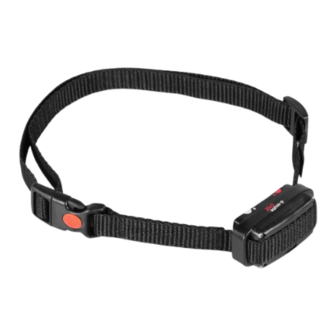
Dog trace d-mute ONE Manual
Electronic collar against barking
Hide thumbs
Also See for d-mute ONE:
- Manual (108 pages) ,
- User manual (19 pages) ,
- User manual (13 pages)
Table of Contents
Advertisement
Quick Links
Advertisement
Table of Contents

Summary of Contents for Dog trace d-mute ONE
- Page 1 Machine Translated by Google CZ EN CZ d-mute Electronic collar against barking...
- Page 2 Machine Translated by Google d-mute ONE - Chapter 3 Charging - chapter 4.2 Charging = orange LED lights up Charging complete = LED turns off...
- Page 3 Machine Translated by Google 3. Turn on - chapter 4.4 4. Mode selection - chapter 4.5 < 0.5 s > 1 sec Correction level Regime Number of beeps Rising Tone / — On Off Descending tone Car software Impulse soft Car hard Impulse hard —...
- Page 4 Machine Translated by Google 5. Selection of sensitivity - chapter 4.6 Number of beeps Sensitivities The lowest The highest 6. Putting on the collar - chapter 5 7. Impulse Test – Chapter 6...
-
Page 5: Table Of Contents
Machine Translated by Google CONTENT 1. Important Notices ........2. -
Page 6: Package Contents
Machine Translated by Google Do not leave the collar on the dog for more than 12 hours a day. Long-term contact points on the dog's skin can cause irritation. If this happens, do not use the electronic collar until all traces of irritation have disappeared. Do not use the collar with the electronic receiver to lead or restrain the dog. -
Page 7: Device Preparation
4.2 Charging The d-mute ONE anti-barking collar contains a Li-Pol battery. The battery must be charged before using the device for the first time. 1. Connect the power cord with the clip to the device as shown in Figure 2 on page 2. -
Page 8: Checking The Battery Status 4.4
4.4 Switching on / off the collar The d-mute ONE collar is controlled using a magnetic switching system, which is activated by applying a magnet to marked points on the device. To turn on, place the magnet (Fig. 1/5) at 0.5 s to the red point marked M (Mode) according to Fig. -
Page 9: Setting The Collar Mode (Acoustic And Stimulation Pulse)
Machine Translated by Google 4.5 Setting the collar mode (acoustic and stimulation pulse) After switching on, the collar automatically switches to automatic mode (mode 1). In this mode, when the dog barks, the level of the stimulation impulse gradually increases automatically. -
Page 10: Setting The Sensitivity Of The Bark Sensor
4.6 Setting the sensitivity of the bark sensor The d-mute ONE collar detects barking using a special sensor that reacts to the vibrations of the dog's vocal cords when barking (sometimes growling and whining) and does not react to the sound made when barking. -
Page 11: Putting The Collar On The Dog
Machine Translated by Google 5. Putting the collar on the dog The dog must have a device placed on the lower part of the neck (on the vocal cords) in order for the receiver to correctly evaluate its barking - fig. 6 on page 4. The belt (collar) must be sufficiently tight so that it cannot move around the dog's neck, but at the same time it must not choke. -
Page 12: Troubleshooting
Machine Translated by Google 6. Troubleshooting 1. Please read this user manual again and check whether the problem is caused by improper use or low battery. 2. If the dog does not respond to stimulation impulses: Check again that the battery in the collar is charged. Test the functionality of the device using a test glow plug (see point 3 of this chapter). -
Page 13: Data
7. Maintenance The d-mute ONE collar is waterproof only if the seal in the upper cover of the collar is in good condition. When replacing the battery, check the condition of the seal and remove any dirt from the seal. Tighten the upper cover screws with adequate force. -
Page 14: Warranty Card
Machine Translated by Google Declaration of Conformity The manufacturer VNT electronics s.r.o. declares that the Electronic anti- barking collar Dogtrace d-mute ONE is in accordance with the Council of Europe Directive 2014/53/EC and corresponds to all valid standards. More at www.dogtrace.com.












Need help?
Do you have a question about the d-mute ONE and is the answer not in the manual?
Questions and answers